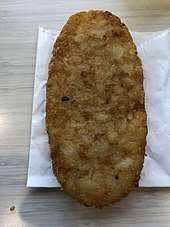Hash browns
Hash browns, also spelled hashed browns, are a popular American breakfast dish consisting of pan-fried shredded, diced, julienned or riced potatoes; some recipes add diced or chopped onions. [1] Hash browns first started appearing on breakfast menus in New York City in the 1890s. Hash browns are a staple breakfast food at diners in North America, where they are often fried on a large common cooktop or grill.[2]
.jpg) Shredded hash browns, pictured with slider sandwiches | |||||||
| Alternative names | Hashed brown potatoes | ||||||
|---|---|---|---|---|---|---|---|
| Place of origin | United States | ||||||
| Invented | 1890 | ||||||
| 326 kcal (1365 kJ) | |||||||
| |||||||
In some parts of the United States, hash browns strictly refer to shredded or riced pan-fried potatoes, while diced and pan-fried potatoes are called country fried potatoes or home fries and are served as a side dish at other meals.[2]
Hash browns are a popular mass-produced product sold in refrigerated, frozen[3][4] and dehydrated forms.
History
Originally, the full name of the dish was "hashed brown potatoes" (or "hashed browned potatoes"), of which the first known mention is by American food author Maria Parloa (1843–1909) in her 1887 Kitchen Companion, where she describes the dish of "hashed and browned potatoes" as a fried mixture of cold boiled potatoes which is folded "like an omelet" before serving.[5] The name was gradually shortened to 'hash brown potatoes'.[6]
Etymology
The word "hash" is derived from the French word "hacher" which means to hack or chop.[7] This means hashed browned potatoes literally translates to "chopped and fried potatoes".
Preparation
.jpg)
A chef may prepare hash browns by forming riced potatoes into patties before frying with onions (moisture and potato starch can hold them together); however, if a binding agent is added (egg or oil for example), such a preparation constitutes a potato pancake. Frozen hash browns are sometimes made into patty form for ease of handling, and the compact, flat shape can also be cooked in a toaster oven or toaster. If a dish of hash browned potatoes incorporates chopped meat, leftovers, or other vegetables, it is more commonly referred to as hash.[2]

Hash browns are also manufactured as a dehydrated food, which is sometimes used by backpackers.[8]
See also
References
- Spieler, M.; Giblin, S. (2012). Yummy Potatoes: 65 Downright Delicious Recipes. Chronicle Books LLC. p. 24. ISBN 978-1-4521-2528-2. Retrieved January 5, 2017.
- Slater, Nigel (November 4, 2006). "Nigel Slater: Making a hash of it". The Guardian.
- Butts, L. (2000). Okay, So Now You're a Vegetarian: Advice and 100 Recipes from One Vegetarian to Another. Broadway Books. p. 64. ISBN 978-0-7679-0527-5. Retrieved January 5, 2017.
- Snider, N.; Boisvert, C. (1985). Frozen Food Encyclopedia for Foodservice: Formerly Frozen Food Institutional Encyclopedia. National Frozen Food Association. p. 114. Retrieved January 5, 2017.
Frozen hash browns are scored on color, defects, texture; grading also is based on flavor and odor.
- Parloa, Maria (1887). Miss Parloa's kitchen companion : a guide for all who would be good housekeepers. Boston : Estes and Lauriat. Retrieved 6 December 2019.
- H. L. Mencken (2012). American Language Supplement 2. Knopf Doubleday Publishing Group. ISBN 9780307813442. Retrieved 2 December 2015.
- "Online Etymology Dictionary". etymonline.com. Retrieved 2017-05-25.
- Miller, D. (1998). Backcountry Cooking: From Pack to Plate in 10 Minutes. Mountaineers Books. ISBN 978-1-59485-292-3. Retrieved January 5, 2017.
External links
| Wikimedia Commons has media related to Hash browns. |
| Look up hash browns in Wiktionary, the free dictionary. |